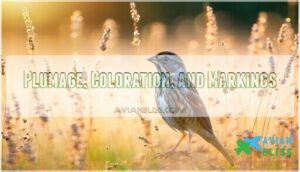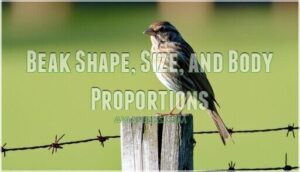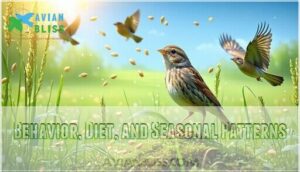This site is supported by our readers. We may earn a commission, at no cost to you, if you purchase through links.

You’ll find roughly 85% of the global population in Mexico, with Arizona hosting about 25,000 individuals. These birds stick to desert grasslands and coastal prairies year-round, foraging on the ground for grasshoppers and crickets in summer before switching to seeds when temperatures drop.
Their subtle appearance and specialized habitat needs make identification tricky, but understanding their behavior and preferred haunts opens the door to spotting these elusive sparrows.
Table Of Contents
- Key Takeaways
- Botteri’s Sparrow Identification Guide
- Habitat and Geographic Range
- Behavior, Diet, and Seasonal Patterns
- Conservation Status and Threats
- Fascinating Facts About Botteri’s Sparrow
- Frequently Asked Questions (FAQs)
- What is the average lifespan of Botteris Sparrow?
- How do Botteris Sparrows adapt to changing environments?
- What are the main predators of Botteris Sparrows?
- How do Botteris Sparrows interact with other bird species?
- What is the typical nesting site of Botteris Sparrows?
- How long do Botteris Sparrows typically live?
- What predators commonly threaten Botteris Sparrow populations?
- Do Botteris Sparrows migrate or stay year-round?
- How does climate change affect Botteris Sparrow?
- Can Botteris Sparrows hybridize with other species?
- Conclusion
Key Takeaways
- Botteri’s Sparrow thrives in tall desert grasslands and coastal prairies across Mexico, Arizona, and Texas, where its muted brown plumage and ground-foraging behavior make it nearly invisible among bunchgrasses, though its distinctive "bouncing ball" song reveals its presence during breeding season.
- This sparrow’s survival depends on intact grassland habitat with minimal grazing, as over 95% of Arizona’s sacaton grasslands have disappeared since the 1800s due to overgrazing, fragmentation, and climate-driven drought intensifying shrub encroachment.
- The species shows remarkable dietary flexibility, shifting from a summer diet dominated by grasshoppers and crickets (over 70% insect biomass) to seed consumption in winter, with breeding cycles timed precisely to monsoon rains that boost insect availability.
- While currently listed as "Least Concern," regional populations face isolated declines and taxonomic uncertainties across up to nine subspecies, making ongoing conservation efforts in protected Arizona and Texas refuges critical for maintaining connectivity among fragmented populations.
Botteri’s Sparrow Identification Guide
Identifying Botteri’s Sparrow can feel like searching for a needle in a haystack, since this bird blends seamlessly into its grassland home.
The key is learning what sets it apart—its subtle coloring and unmistakable song—so you can distinguish it from similar species.
Plumage, Coloration, and Markings
If you’re used to sparrows with flashy field marks, Botteri’s Sparrow might leave you scratching your head at first glance, since its plumage is a study in subtlety rather than showmanship. You’ll notice brown, rust, and tan tones blending across its body, with markings camouflage perfectly suited for grassland life.
The color pattern lacks bold streaking or eye-catching contrast, making sparrow identification tricky. Juvenile plumage shows similar muted characteristics, so don’t expect dramatic changes between ages when studying Botteri’s Sparrow identification.
Beak Shape, Size, and Body Proportions
Beyond those muted colors, you’ll want to pay attention to the bird’s structure, which tells you just as much about Botteri’s Sparrow as its plumage does. You’ll notice a flat head and heavy beak morphology that’s fairly thick for insect-catching.
They typically weigh between 0.6 and 0.9 ounces and measure 5.9 to 6.7 inches long, with a notably long tail.
When you’re out in the field, these size and shape proportions become essential clues for confirming you’ve spotted a Botteri’s Sparrow.
Distinguishing Features Vs. Similar Species
When you’re out scanning grasslands, Identification Challenges arise because Botteri’s looks a lot like Cassin’s Sparrow. Plumage Variations are subtle, so you’ll rely on Morphological Differences and Vocalization Analysis. Here’s what sets Botteri’s apart:
- Bill shape: Botteri’s has a longer, thicker bill with a curved culmen
- Back pattern: Faint streaks on brown plumage, not scalloped like Cassin’s
- Underparts: Completely unstreaked belly and flanks
- Head shape: Flatter profile compared to Cassin’s rounded crown
- Regional Differences: Arizona birds show rustier tones; Texas populations appear paler
The Botteri’s Sparrow, or Peucaea botterii, is a species often found in southern Texas. Habitat Overlap with Grasshopper Sparrow occurs, but Botteri’s prefers taller sacaton grass and skulks low rather than perching upright.
Unique Songs and Vocalizations
You’ll know a Botteri’s Sparrow is nearby long before you spot one, thanks to its unmistakable "bouncing ball" song that accelerates like a ping-pong ball settling on a table.
You’ll recognize Botteri’s Sparrow by its distinctive bouncing ball song long before you ever see the bird itself
This distinctive bird song has multiple functions, including territory defense and mate attraction. Song uniqueness makes Botteri’s Sparrow identification reliable even when visual cues fail.
Listen carefully—you’ll hear it most often during midday heat when males sing from exposed perches, their vocal repertoire cutting through the stillness of desert grasslands.
Habitat and Geographic Range
Botteri’s Sparrow lives in scattered pockets across Mexico, Central America, and parts of the southwestern United States, where it sticks to specific grassland habitats that meet its needs.
You’ll find this species in different types of environments depending on the region, and understanding where it thrives helps you know where to look.
Native Regions and Disjunct Distribution
Botteri’s Sparrow has an unusual, patchy range across Mexico, Arizona, and southern Texas.
Over time, habitat loss split these populations apart, and each isolated group has evolved into distinct regional subspecies.
Roughly 85% of the global population resides in Mexico, while Arizona harbors about 25,000 individuals—less than 15% of the total. The species thrives in subtropical grasslands, which are essential for their survival.
When breeding populations get cut off from each other like this, conservation gets complicated—each isolated group deals with its own set of regional challenges.
Preferred Grassland and Prairie Environments
When you picture the ideal home for Botteri’s Sparrow, think tall grasses swaying in warm breezes—the kind of grassland that offers both shelter and sustenance throughout the year.
You’ll find this grassland sparrow thriving in desert grasslands dominated by sacaton grass, along with coastal prairie habitats in Texas.
These arid adaptation specialists need ungrazed or lightly grazed areas where habitat fragmentation hasn’t taken hold—places where vegetation stands tall enough to conceal nests and provide rich insect foraging grounds.
Regional Differences in Habitat Use
Botteri’s Sparrow shows dramatically different habitat preferences across its range in desert grasslands versus coastal prairies.
Arizona populations favor elevated desert landscapes with tall sacaton reaching up to 1,500 meters, supporting densities of two birds per acre in biodiversity hotspots. Texas birds occupy low coastal zones, often within 10 meters elevation, where habitat fragmentation and shorter grasses reduce densities below one per acre.
These regional adaptation patterns reflect distinct grassland ecology shaped by elevation, vegetation structure, and local climate regimes.
Adaptation to Human-Modified Landscapes
Human developments have reshaped grassland ecosystems in ways that challenge Botteri’s Sparrow survival, yet some populations show surprising resilience in moderately altered habitats. You’ll find these birds persisting in lightly grazed rangelands where conservation efforts maintain native grassland habitat despite habitat fragmentation.
But cities and intensive farming are eating away at their habitat fast, throwing off the whole landscape balance.
When you look at how humans affect Botteri’s Sparrow territory, you see a mixed bag—some areas bounce back surprisingly well, while others need serious protection before it’s too late.
Behavior, Diet, and Seasonal Patterns
Understanding Botteri’s Sparrow means watching how it actually lives—the rhythms that shape its days and seasons.
We’ll explore their feeding strategies, social dynamics, breeding cycles, and survival tactics.
Foraging Habits and Food Sources
You’ll find Botteri’s Sparrow foraging almost entirely on the ground, hopping through tall bunchgrasses to snatch up grasshoppers and crickets. Their insect diet dominates during summer—over 70% insect biomass when prey is abundant—while seed consumption increases markedly in winter.
These dietary adaptations reflect seasonal availability, with foraging strategies shifting from insect hunting during monsoon-driven peaks to seed-focused feeding when arthropods decline. Food preferences clearly favor grasshoppers during breeding, supporting both adults and nestlings in prime grassland habitat.
Social Structure and Breeding Behavior
If you’ve ever wondered whether sparrows form tight-knit social bonds or prefer the single life, you’ll find that Botteri’s Sparrows lean heavily toward solitary foraging—though pairs and family groups do appear during breeding season.
Monogamous pairs form with the onset of summer rains, triggering mating rituals and nesting habits tied directly to moisture. Both parents share fledgling care responsibilities, feeding nestlings for roughly 10 days before young birds leave the nest, then maintaining parental bonds for an additional 17–25 days post-fledging.
Seasonal Occurrence and Breeding Seasons
Timing matters more than you might think—Botteri’s Sparrows don’t just pick any random week to start a family, as their breeding windows shift dramatically depending on where you’re in their range. Regional breeding patterns follow moisture, not calendar dates:
- Arizona populations nest from roughly July 10 through September 1, synced with monsoon rains
- Texas birds begin nesting cycles earlier in summer when coastal moisture arrives
- Southern subspecies in Mexico and Central America show varied seasonal occurrence patterns tied to local rainfall
- Breeding evidence appears when grasshopper populations peak, fueling mating habits
- Fledging rates improve when summer storms sustain insect abundance through August
These sparrows don’t migrate seasonally—they’re year-round residents adjusting breeding habits to environmental cues.
Predator Avoidance and Defense Mechanisms
Surviving in open grasslands takes more than just good timing—you’ve got to stay invisible when hawks circle overhead and coyotes patrol the understory. Botteri’s Sparrow behavior relies on camouflage techniques, with cryptic brown plumage blending into dried grass.
For predator detection, these birds freeze motionless at threat response moments, then use evasive maneuvers—short, low flights into dense vegetation. Defense strategies focus on stillness over flight, a habitat and behavior adaptation vital for Botteri’s Sparrow conservation efforts protecting ground-nesting populations.
Conservation Status and Threats
Botteri’s Sparrow faces real challenges that threaten its future, from shrinking grasslands to gaps in our scientific understanding.
Here’s what’s threatening the species—and the efforts underway to save it.
Population Trends and Regional Declines
Unfortunately, Botteri’s Sparrow populations have faced significant regional extirpation and species fragmentation over the past century. Population trends reveal that Arizona lost all recorded individuals between 1903 and 1932 due to severe grassland degradation from overgrazing. While Arizona populations have since stabilized at roughly 25,000 breeding individuals, Texas and New Mexico continue experiencing declines.
New Mexico’s Animas Valley recorded only 21 singing males in 1995, highlighting ongoing population shifts. Despite its IUCN Status of "Least Concern," targeted Botteris Sparrow conservation and monitoring remain essential.
Habitat Loss, Fragmentation, and Climate Impacts
The factors driving Botteri’s Sparrow decline are interconnected. Grassland degradation and habitat loss have eliminated over 95% of Arizona’s sacaton grasslands, the species’ primary breeding habitat, since the late 1800s. You can see three major ongoing threats:
- Habitat fragmentation from roads and development increases predation risk and edge effects
- Climate shifts intensify droughts, favor shrub encroachment, and reduce insect prey availability
- Ecosystem disruption from altered fire regimes destroys mature grassland needed for nesting
Desert grassland ecosystems face compounded pressures, making Botteri’s Sparrow habitat increasingly vulnerable to biodiversity loss.
Current Conservation Efforts and Protected Areas
Three major federal refuges and a handful of state-protected grasslands now serve as critical strongholds for Botteri’s Sparrow populations in the United States. These protected areas are concentrated in southeast Arizona and south Texas, where habitat preservation efforts focus on maintaining sacaton grasslands.
Conservation policies emphasize environmental monitoring and grazing management, while organizations like the Tucson Bird Alliance aid bird conservation through habitat restoration and public education programs aimed at addressing habitat loss.
Taxonomic Complexities and Research Needs
Botteri’s Sparrow has up to nine subspecies that scientists still can’t agree on. The problem? We don’t have enough genetic data from different populations, especially those separated by geography.
Making things harder, the subspecies look remarkably similar—their plumage variations overlap so much that visual identification alone won’t settle the debate.
To nail down which subspecies is which, researchers are turning to bioacoustics—analyzing the birds’ calls and songs—along with landscape genetics to understand how geography shapes populations.
These tools are proving crucial not just for accurate identification, but for understanding where Botteri’s Sparrows live, how they behave, and ultimately how to protect them.
Fascinating Facts About Botteri’s Sparrow
Beyond the "bouncing ball" song and dusty grasslands, Botteri’s Sparrow has more stories to tell.
Here’s a closer look at some fascinating aspects of this secretive bird’s life, from where to spot them to how scientists continue uncovering their secrets.
Notable Sightings and Birdwatching Hotspots
If you’re hoping to catch a glimpse of Botteri’s Sparrow, Southeast Arizona stands out as the top destination in the United States, drawing birders from coast to coast during the summer months. San Rafael Valley remains a consistently productive hotspot location, while local guides and birding tours often check sightings reports to boost rare encounters.
You can find updates through Tucson Bird Alliance’s conservation work, which tracks population trends and helps birdwatchers plan successful trips for birdwatching in Arizona.
Monogamous Mating and Nesting Habits
Once you spot a Botteri’s Sparrow in the grasslands, you might wonder about the private life of this secretive bird—does it pair up for life, and where does it raise its young? While pair bonding details remain understudied, breeding cycles align with summer rains.
The nest is usually a shallow grass cup tucked under vegetation on the ground, offering concealment. Females lay 3 eggs per clutch, and both parents likely share fledgling care duties during the nesting period.
Juvenile Development and Parental Care
After the eggs hatch, you’ll notice that young Botteri’s Sparrows don’t just fly off into the grasslands—they rely on their parents for nearly a month of careful guidance and protection. Nestling growth spans about 12 days before fledgling success, when chicks leave the nest. Parental investment continues another 17–25 days as adults teach foraging skills.
This extended chick development period during breeding season aids brood survival in challenging desert grassland habitat, showcasing critical nesting behavior patterns in Botteri’s Sparrow identification and bird behavior studies.
Ongoing Scientific Studies and Discoveries
Recent advances in genetic research and species taxonomy are reshaping what you know about Botteri’s Sparrow identification and breeding season patterns. Motus tracking technology revealed migration patterns for 16 tagged sparrows in 2025, while citizen science surveys documented over 3,700 individuals in Arizona’s Sonoita Plain.
Scientists are now studying climate adaptation mechanisms and habitat fragmentation thresholds to understand how these birds persist despite drought severity and altered grassland landscapes. This research directly addresses the impact of climate change on the habitat and behavior of sparrows.
Frequently Asked Questions (FAQs)
What is the average lifespan of Botteris Sparrow?
Measuring lifespan in Botteri’s Sparrows isn’t straightforward—there simply isn’t enough data. Captive studies are limited, field observations are scarce, and researchers have yet to establish a documented average for this grassland species.
Predation, environmental conditions, and other survival factors all matter, but hard numbers remain elusive.
Environmental impacts, Predation effects, and Longevity factors all play roles, yet no documented average exists for this elusive grassland species.
How do Botteris Sparrows adapt to changing environments?
When habitat fragmentation and climate change reshape landscapes, Botteri’s Sparrows demonstrate behavioral plasticity by adjusting foraging patterns and dietary shifts.
However, genetic adaptation remains limited given their specialized grassland requirements and vulnerability to habitat loss.
What are the main predators of Botteris Sparrows?
You’ll want to know which nest predator types threaten these sparrows most. Snakes, rodents, and corvids target ground nests, while raptors hunt fledglings in open grassland habitat where defense strategies offer limited protection against population impact.
How do Botteris Sparrows interact with other bird species?
You might think grasslands are bustling social clubs, but Botteri’s Sparrows keep to themselves. These birds usually forage alone or with their mate, showing little interspecies competition with Chestnut-collared Longspurs or House Sparrows in their habitat sharing patterns.
What is the typical nesting site of Botteris Sparrows?
You’ll find the nest tucked on the ground, hidden beneath a canopy of grass and weeds.
Females weave a shallow cup using grass stems, creating shelter where they’ll lay eggs—usually three per clutch. Vegetation cover is essential for nesting success.
How long do Botteris Sparrows typically live?
We don’t have solid lifespan data for Botteri’s Sparrow—the research just isn’t there yet. What kills them? The usual suspects: predators, poor habitat, and brutal weather.
You’ll find breeding impact and foraging behavior influence survival, though average longevity estimates aren’t well established for this species.
What predators commonly threaten Botteris Sparrow populations?
Ground-nesting birds face constant threats from multiple directions. Nest predation poses the greatest risk to Botteri’s Sparrow populations, with mammalian predators like snakes, coyotes, and skunks targeting eggs and fledglings in their grassland habitat.
Do Botteris Sparrows migrate or stay year-round?
Unlike true migrants that chase seasons across continents, you’ll find Botteri’s Sparrows staying year-round in their breeding territories.
These sparrows show minimal seasonal movements, remaining in familiar grasslands through winter rather than undertaking long-distance migration.
How does climate change affect Botteris Sparrow?
Climate change disrupts Botteri’s Sparrow through altered rainfall changes and temperature effects in desert grassland. These shifts affect food availability, especially grasshoppers, while potentially forcing habitat shifts and altering migration patterns as invasive species encroach on preferred territories.
Can Botteris Sparrows hybridize with other species?
No documented cases of Botteri’s Sparrow hybridization exist, though subspecies interbreeding remains possible where geographic distribution overlaps.
Their reproductive isolation and unique behavioral patterns probably keep them from interbreeding with other sparrow species, which helps preserve the species’ genetic distinctiveness.
Even though we don’t have much research yet on whether they could produce viable hybrid offspring.
Conclusion
Like a whisper in tall grass, Botteri’s sparrow rewards patience and persistence. You’ve learned how this elusive bird navigates desert grasslands with its camouflaged plumage, bouncing-ball song, and ground-foraging habits. Spotting one demands attention to habitat, behavior, and vocalizations.
As grasslands face growing threats, understanding Botteri’s sparrow helps protect these specialized environments. Your next birding trip might reveal this secretive species—if you know where to listen and what to watch for in the rustling bunchgrass.











